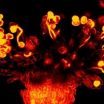Published this week in the peer-reviewed journal Clinical Cancer Research, the study also identified a subset of patients more likely to respond to the vaccine, those with a subtype of glioblastoma known as mesenchymal, which accounts for about one-third of all cases. This is the first time in brain cancer that a subset of patients more likely to respond to an immunotherapy has been identified, said Dr. Linda Liau, a Jonsson Cancer Center researcher, professor of neurosurgery and senior author of the study.
The study found that the vaccine, administered after the conventional treatments of surgery and radio-chemotherapy, was associated with a median survival of 31.4 months, double the 15 months of historical controls in the published literature. In all, 23 patients were enrolled in the Phase I study that was launched in 2003. Of those, about one third of participants are still alive, some more than eight years after their diagnosis.
The study also found that the vaccine was safe and that side effects were minimal, limited mostly to flu-like symptoms and rashes near the vaccine injection site.
"This is quite an encouraging result, especially in an early phase study like this," Liau said. "It's promising to see patients with this type of brain cancer experience such long survivals."
However, Liau cautioned that the findings need to be confirmed in larger, randomized studies. She currently is leading a Phase II, randomized study at UCLA testing the vaccine in newly diagnosed glioblastoma patients. The patients will receive either the standard of care (surgery, radiation and chemotherapy) or the standard of care plus the vaccine. The study is a multi-center trial, and UCLA is the only site offering it in California.
It has recently been discovered that there are at least three subtypes of glioblastoma: proneural, proliferative and mesenchymal. During the course of her study, Liau and her colleagues saw that one group of patients seemed to be responding very well to the vaccine and examined their tumors using a microarray analysis of their DNA. They found that those with a gene expression profile identifying their cancers as mesenchymal responded better to the vaccine.
The finding was surprising, Liau said, because patients with the mesenchymal subtype generally have more aggressive disease and shorter survival than those with the other subtypes. In patients with this type of glioblastoma, several genes that modulate the immune system are dysregulated, meaning they don't work properly. Liau speculates that the vaccine helped replenish the immune system, allowing that subset of patients to more easily fight the brain cancer.
"Glioblastoma remains one of the diseases for which there is no curative therapy … and the prognosis for patients with primary malignant brain tumors remains dismal," the study states. "Our results suggest that the mesenchymal gene expression profile may identify an immunogenic sub-group of glioblastoma that may be more responsive to immune-based therapies."
Brad Silver, 41, who grew up in Southern California and now lives in a Cleveland suburb, was diagnosed with glioblastoma in 2003 and was told that he had, at best, two months to live. He was stunned.
"I was 33 years and my wife was seven months pregnant with my son," said Silver, a college water polo instructor. 'I didn't think I was going to live to see my son born, let alone grow up."
Silver sought a second opinion at UCLA and the golf-ball sized tumor in his left lateral lobe was removed. He underwent radiation and chemotherapy and enrolled in the vaccine clinical trial. Today, eight years later, he remains cancer free. His son, named Brad Silver II and a miniature version of his dad, will celebrate his eighth birthday in April.
"If I had listened to that first doctor, I would not be here today. If not for Dr. Liau, I would not be here today," Silver said. "I'm 100 percent back to being me because of this vaccine and that clinical trial. It's almost unbelievable."
The vaccine preparation is personalized for each individual. After the tumor is removed, Liau and her team extract the proteins, which provide the antigens for the vaccine to target. After radiation and chemotherapy, the white blood cells are taken from the patient and grown into dendritic cells, a type of white blood cell that is an antigen-presenting cell. The vaccine preparation from this point takes about two weeks, as the dendritic cells are grown together with the patient's own tumor antigens. The tumor-pulsed dendritic cells are then injected back in to the body, prompting the T cells to go after the tumor proteins and fight the malignant cells.
"The body may have trouble fighting cancer because the immune system doesn't recognize it as a foreign invader," Liau said. "The dendritic cells activate the patient's T cells to attack the tumor, basically teaching the immune system to respond to the tumor."
The individualized vaccine is injected into the patient in three shots given every two weeks for a total of six weeks. Booster shots are given once every three months until the cancer recurs. Patients are scanned every two months to monitor for disease recurrence, Liau said.
INFORMATION:
This study was funded in part by the National Institutes of Health, the Philip R. and Kenneth A. Jonsson Foundation, the Neidorf Family Foundation, STOP Cancer, the Ben & Catherine Ivy Foundation and Northwest Biotherapeutics, Inc.
UCLA's Jonsson Comprehensive Cancer Center has more than 240 researchers and clinicians engaged in disease research, prevention, detection, control, treatment and education. One of the nation's largest comprehensive cancer centers, the Jonsson center is dedicated to promoting research and translating basic science into leading-edge clinical studies. In July 2010, the Jonsson Cancer Center was named among the top 10 cancer centers nationwide by U.S. News & World Report, a ranking it has held for 10 of the last 11 years. For more information on the Jonsson Cancer Center, visit our website at http://www.cancer.ucla.edu.
END

